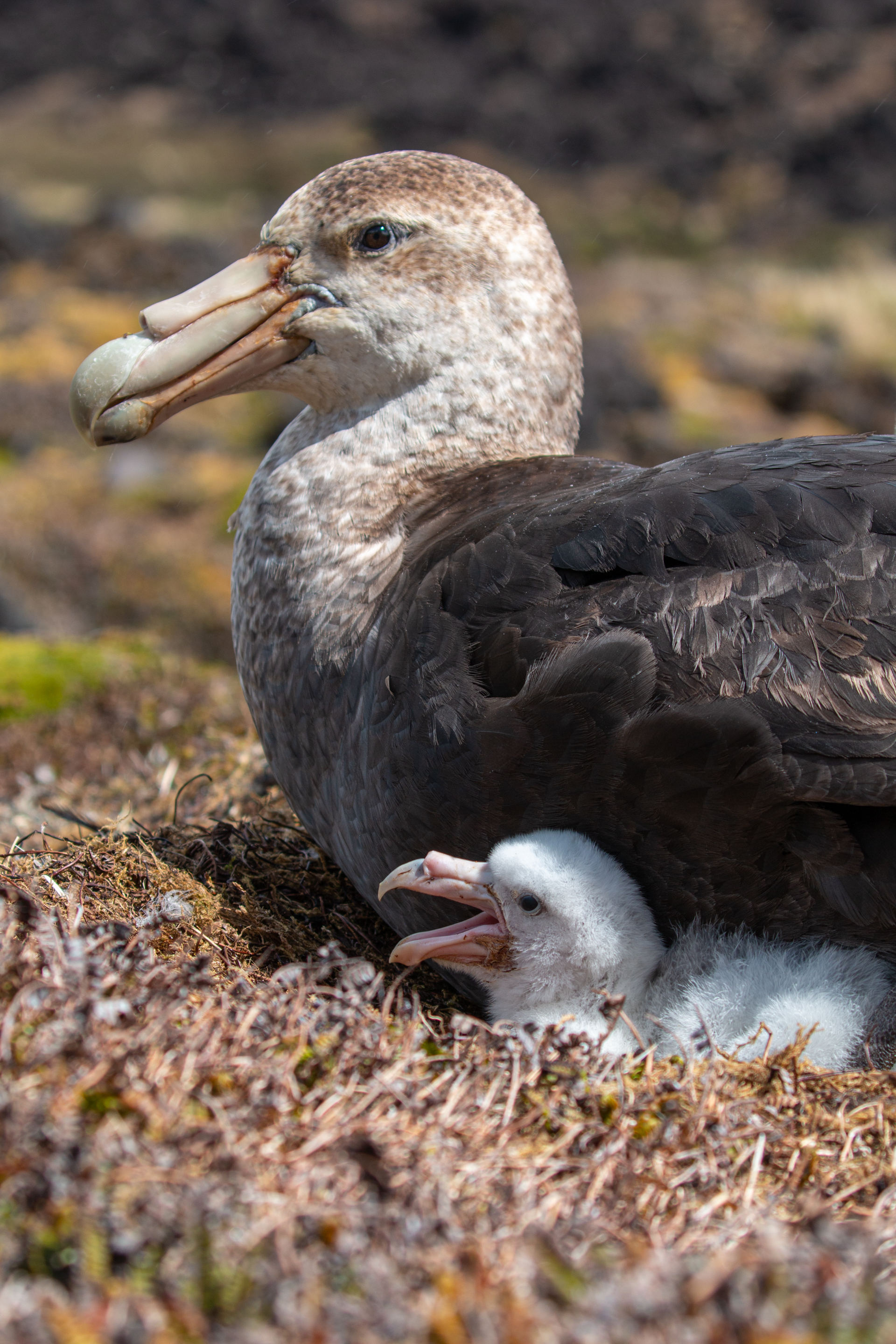
Southern Giant Petrel breeding on Long Beach, Gough Island, watercolour by Susanne Durchholz; after a photograph by Michelle Risi
Note: The illustrated Species Summaries have been written to help inform the general public, including school learners, of the biology and conservation needs of the 31 ACAP-listed species. They serve to complement the more detailed and referenced ACAP Species Assessments. To date, summaries for the 22 species of albatrosses have been produced in in all three ACAP official languages, English, French and Spanish.
Texts have also been prepared for the nine ACAP-listed petrels and shearwaters in English, but as yet have not been translated into French and Spanish. As an interim service, the illustrated English texts are being posted to ACAP Latest News, starting here with the Southern Giant Petrel Macronectes giganteus.

A Southern Giant Petrel broods its small chick on Marion Island; photograph by John Dickens
The Southern Giant Petrel is one of the two largest petrels in the family Procellariidae. They are so large they do not need to breed in burrows to be protected from predators. The closely related and similar looking Northern Giant Petrel was only recognized as a separate species in the 1960s.
The Southern Giant Petrel occurs in two colour phases. Most birds are all-over brown with a yellowish to horn-coloured bill which has a diagnostic green tip, separating it from the northern species which has a reddish tip to its bill. Brown-phase juveniles have a plain dark brown plumage, older birds become variously mottled with pale brown to grey feathers. The rarer white-phase birds are overall white with a scattering of black body feathers. Males are larger than females, most noticeable when the bills of a breeding pair are compared side by side.
The species breeds in the austral summer on many Southern Ocean islands and on the Antarctic Continent, laying a single egg on the ground in colonies, that may vary greatly in size. The global population was estimated at 48 000 - 54 000 pairs in 2008/09. By far the largest numbers (19 500 pairs) are found in the Falkland Islands/Islas Malvinas, a disputed territory* in the South Atlantic. The northernmost breeding site is Gough Island, where a few hundred pairs breed. Colonies also exist on the Antarctic Continent, including on islands along the Antarctic Peninsula – where more white-phase birds are present, compared with the sub-Antarctic island populations. Population trends vary throughout the species’ range but are increasing in the large colonies in the South Atlantic, resulting in the species being categorized as of Least Concern.
Southern Giant Petrels may be seen at sea throughout the Southern Ocean, as well as offshore along the coasts of southern Africa and southern South America. Banding and tracking studies show individuals can travel great distances. The species’ diet is catholic, scavenging on seal carcasses and preying on seabirds, including penguins, on land and feeding on marine life (krill, squid, fish) caught at sea, as well as scavenging behind fishing vessels. The smaller females feed more than males do at sea, thought due to their avoiding competing with larger males scavenging ashore.
Threats included being killed as bycatch by longline fisheries, notably by IUU (Illegal, Unreported and Unregulated) fisheries for toothfish in the Southern Ocean in the 1990s; now largely eliminated by the adoption of mitigation measures (such as deploying bird-scaring lines) by the legal fisheries and concerted international action against the poaching vessels. Human disturbance at breeding sites, including from tourists, is largely addressed by way of management plans or equivalents defining minimum approach distances. Most breeding sites are proclaimed nature reserves or equivalents, several with international status coming from the World Heritage and Ramsar Wetlands Conventions. Most of the sub-Antarctic islands where the species breeds are surrounded by large Marine Protected Areas.
Sources:
ACAP 2012. Southern Giant Petrel Macronectes giganteus.
BirdLife International 2021. Species factsheet: Macronectes giganteus.
John Cooper, ACAP Information Officer, 08 March 2022
*A dispute exists between the Governments of Argentina and the United Kingdom of Great Britain and Northern Ireland concerning sovereignty over the Falkland Islands (Islas Malvinas), South Georgia and the South Sandwich Islands (Islas Georgias del Sur y Islas Sandwich del Sur) and the surrounding maritime areas.

 Español
Español  English
English  Français
Français